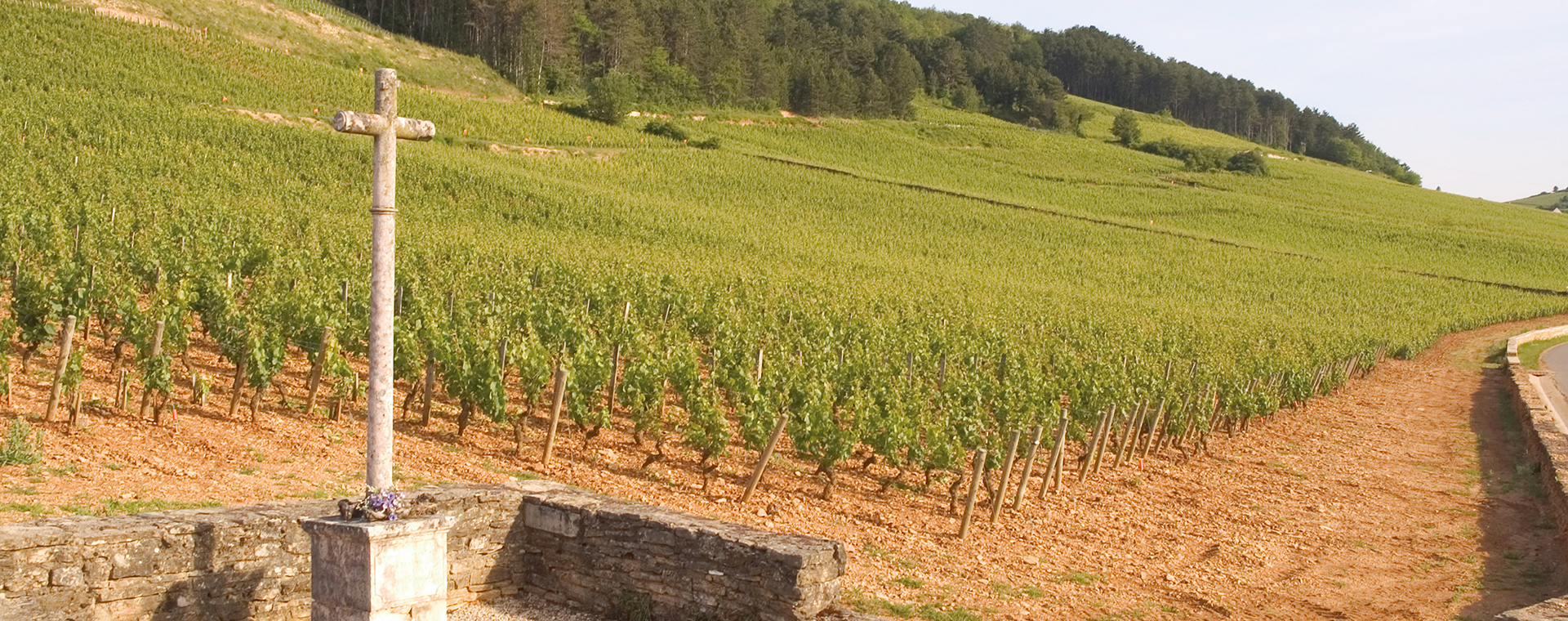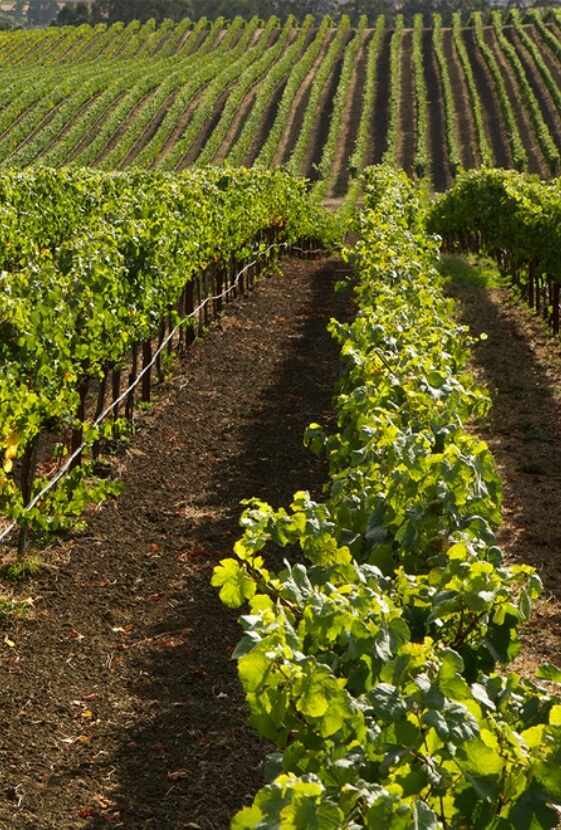
Terroir & Vineyards

Perhaps nowhere else in the world is terroir expression more pronounced and coveted than in the Côte d’Or. With a continental climate, the specific combination of soils, exposure and microclimates within Burgundy’s venerated vineyards cultivates some of the world’s most highly esteemed grapes.
Historic rules of inheritance have fragmented ownership so that most vineyards are divided into multiple parcels. Since its founding, and particularly since the mid-1980s, Maison Louis Jadot has made it a long-term policy to acquire the finest vineyard lands when they become available. This has consolidated some of the purest expressions of Burgundy’s terroir in Jadot holdings.
Chablis
Located to the north of the Côte d’Or and separate from it is Chablis, which produces racy, mineral white wines from Chardonnay grown on typical white limestone and clay soils containing tiny fossilized shells.
The Côte d’Or
The Côte d’Or is a narrow, east-facing slope of differing limestone-based soils. At the top and bottom of the slope, the soil quality and aspect are considered second to the elevations in mid-slope, where Premier and Grand Cru vineyards tend to reside at 250 to 300 meters on well-draining limestone soil with an ideal exposure to sunlight.
The Côte d’Or is divided into two main regions, the Côte de Nuits in the north, known for producing world-class red wines from Pinot Noir, and the Côte de Beaune, in the south, best known for white wines from Chardonnay, but producing its share of reds as well.
Côte de Nuits Grands Crus
Of the 23 Grands Crus in the Côte de Nuits, Maison Louis Jadot produces wines from 14:
- Mazis-Chambertin
- Chambertin Clos de Bèze
- Chambertin
- Chapelle-Chambertin
- Charmes-Chambertin
- Latricières-Chambertin
- Griotte-Chambertin
- Clos de la Roche
- Clos-Saint-Denis
- Bonnes Mares
- Musigny
- Clos Vougeot
- Echézeaux
- Grands Echézeaux
Côte de Nuits Premiers Crus
Maison Louis Jadot produces 15 Premier Cru wines from the Côte de Nuits, 9 of them from wholly owned vineyards.
- In Gevrey-Chambertin: Clos Saint Jacques, Estournelles Saint Jacques, Lavaux-Saint-Jacques, Petite Chapelle, Poissenots
- In Chambolle-Musigny: Les Amoureuses, Les Baudes, Les Charmes, Les Feusselottes, Les Fuées
- In Vosne-Romanée: Les Beaux Monts, Les Suchots, Malconsorts
- In Nuits-Saint-Georges: Les Boudots
Côte de Nuits Village Wines
Jadot’s village wines are grown on an extension of the slopes where the Premiers and Grands Crus are situated. Among the Côte de Nuits villages, Gevrey-Chambertin is the most renowned. Here, Pinot Noir has been refined to a pinnacle of expression. Nuits-Saint-Georges is the southernmost commune of the Côte de Nuits and produces some of its sturdiest and longest-lived wines. Other Louis Jadot village wines from the Côte de Nuits are:
- Marsannay (red and white)
- Fixin (red and white)
- Chambolle-Musigny (red)
- Vosne-Romanée (red)
- Côte de Nuits Villages (red and white)
- Côte de Beaune Grands Crus
Soil and aspect are crucial to Grand Cru vineyard siting, and soils vary widely in the Côte de Beaune. The Grand Cru white Montrachet is perfectly situated on a strip of east-facing limestone for an intense wine of great depth and aging potential. Surrounding Grands Crus include Chevalier-Montrachet, on stonier soil, and Bâtard-Montrachet, on heavier soil. At the northern border of the Côte de Beaune, the hill of Corton produces both a white and a red Grand Cru: the white on the upper south- and west-facing slopes on brown marl soil with limestone washed down from above; the powerful red is produced on a band below the white. Following are the Maison Louis Jadot Côte de Beaune Grands Crus:
- Corton Charlemagne
- Corton-Grèves (red)
- Corton-Pougets (red)
- Bâtard-Montrachet
- Bienvenues-Bâtard-Montrachet
- Criots-Bâtard-Montrachet
- Chevalier-Montrachet
- Chevalier-Montrachet Les Demoiselles
- Montrachet
Côte de Beaune Premiers Crus
Louis Jadot’s greatest presence is in the Côte de Beaune, and this can be seen clearly in the house’s 50 Premiers Crus from the region.
- In Pernand-Vergelesses: Clos de la Croix de Pierre (red)
- In Savigny-lès-Beaune: Clos des Guettes, Hauts-Jarrons, La Dominode, Les Lavières, Les Vergelesses
- In Beaune: Premier Cru, Avaux, Boucherottes, Bressandes, Bressandes Blanc, Cent Vignes, Chouacheux, Clos des Couchereaux, Clos des Ursules, Grèves, Les Grèves Le Clos Blanc, Pertuisots, Theurons, Thuvillains
- In Pommard: Clos de la Commaraine, Epenots, Grands Epenots, Rugiens
- In Volnay: Clos de la Barre, Clos des Chênes
- In Meursault: Blagny, Charmes, Genevrières, Goutte-d’Or, Perrières, Porusot
- In Puligny-Montrachet: Champ-Gain, Clos de la Garenne, Folatières, Les Combettes, Les Pucelles, Perrières, Referts, Garenne
- In Chassagne-Montrachet: Caillerets, Chenevottes, Grande Montagne, Grandes Ruchottes, La Romanée, Morgeot Blanc Clos de la Chapelle, Morgeot Rouge, Abbaye de Morgeot
Côte de Beaune Village Wines
In the Côte de Beaune, Chassagne-Montrachet, Meursault and Puligny-Montrachet are the three most famous white wine villages. Chassagne-Montrachet, reputed for its great Grands Crus, produces village whites that are the most robust in style. Meursault is often considered masculine in style compared to Puligny-Montrachet, which is charming, elegant and feminine. For red wine, Pommard is the most recognized village of the Côte de Beaune and often considered the most masculine red wine of the Côte. Other Louis Jadot village wines from the Côte de Beaune are:
- Ladoix (white)
- Pernand-Vergelesses (red and white)
- Aloxe-Corton (red)
- Chorey-lès-Beaune (red)
- Savigny-lès-Beaune (red and white)
- Beaune (red and white)
- Pommard (red)
- Volnay (red)
- Auxey-Duresses (red and white)
- Saint-Aubin (red and white)
- Santenay (red and white)
- Côte de Beaune Villages (white)
Innovative Partnerships with Growers
In addition to its practice of farming domaine fruit sustainably, Jadot structures its supply agreements for its non-domaine wines as collaborative partnerships between house and grower oriented solely toward quality. Jadot makes its standards clear to its growers, and lends advice when necessary. No binding contracts exist; neither is under obligation to transact with the other, for reasons of quality on Jadot’s part or for reasons of price on the growers’. Yet Maison Louis Jadot’s policy, if costly, of buying grapes at the price of finished wine, provides the grower a financial advantage with less effort, and ensures Jadot a degree of continuity of supply as well as control over the fruit at the very earliest stage of its transformation into wine.





















